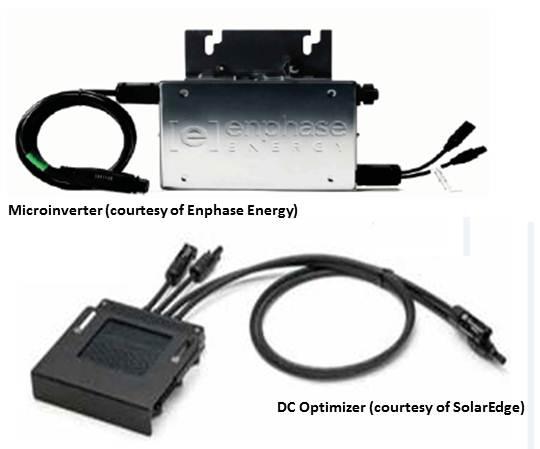With microinverters picking up market share and power optimizers adding versatility to string inverters, what is the best choice for your new solar array?
Just a few years ago, microinverters were the hot new technology in the solar business. Following the introduction of Enphase’s widely successful M175 microinverter in 2008, microinverters gained popularity quickly. Now, power optimizers are offering many of the advantages of microinverters with the lower cost and convenience of central string inverters. What is the best choice?
For readers who may be exploring inverter options for the first time, here is a quick rundown of the three inverter options commonly available on the market today.
“String” Inverters
The oldest and most widely deployed grid-tied option available is called a “string” inverter. This is because there is only one inverter for the array, and the DC panels are wires together in series “strings,” which are converted to grid AC by the central inverter. String inverters are known to be reliable and lower cost than microinverters. However, their performance can be seriously affected by shading, snow cover or broken panels, since all of the panels feed one inverter.
Microinverters have made a big splash in the solar market. Mounted directly on the frame or rack, these little units handle just one panel each. The big advantage of the microinverter is that any shading, snow cover or malfunction affecting one panel does not bring down the performance of the rest of the system. Of course, having lots of tiny inverters is going to be more expensive than one large inverter, in most cases. Plus, with all of the new microinverters on the market, reliability and longevity is still a bit of a question mark. Also, maintenance is more of an issue- replacing one microinverter in the center of a roof-mounted array can be a real headache, compared to swapping out a central inverter in the basement.
Power optimizers are similar to microinverters in the respect that they isolate each panel from the rest of the system, maximizing efficiency and minimizing shading issues. Therefore, both Microinverters and power optimizers are categorized as module-level power electronics (MLPE). However, they do not convert the DC power to AC. That is still done by a central string inverter. The beauty of power optimizers is that they bring a lot of the advantages of microinverters to the system design without the additional cost. In fact, they can bring the system cost down as much as 20 cents per watt, over microinverters.
Microinverter manufacturers insist that their product is inherently safer, because there is no high voltage DC wiring on the roof, Also, they point out that the primary issue with string inverters remains- if your inverter fails, the entire system goes down. If one or more microinverters fail, the rest of the system functions normally.
Power optimizer proponents point to heat issues when mounting microinverters directly under panels– issues that they claim are not present in optimizers. They also point to the linear nature of microinverters. The more panels you have, the more microinverters you need. This means that the larger the array, the greater the savings, when less inverters are needed.
With solar panel prices continuing to decline, microinverter prices have remained relatively flat in the last few years. Enphase continues to dominate the market, with competition from companies like Power One, and more recently, string inverter giant SMA has released a line of microinverters. However, just as some of the inverter industry big boys are dipping their toes into the microinverter market, the power optimizer is rising quickly in popularity, breathing new energy into the central string inverter market. It would appear that power optimizers and so-called AC panels (panels with integrated microinverters) may be headed for a battle royale as solar pushes forward toward ever more efficient system design.







